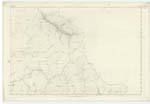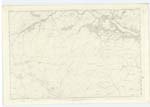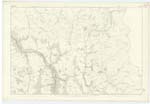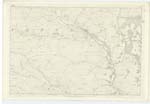OS1/10/14/2
| List of names as written | Various modes of spelling | Authorities for spelling | Situation | Description remarks |
|---|---|---|---|---|
| DURISDEER [parish] | Durisdeer Durrisdeer |
J. & C. Walker's Map of Scotland Blackwood's Map of Dumfriesshire Johnston's Map of Dumfriesshire Crawford's Map of Dumfriesshire Valuation Rolls for 1826 |
007; 013; 014; 021; 022 | [Continued from page 1] most conspicuous hills which form the sides of the aforesaid defiles and in which the scenery is imposing, grand and picturesque, the eye being at frequent intervals relieved from the wild and sombre aspect of a mountain pass, by the soft and green verdure of the hills with numerous fleecy flocks. There are no minerals wrought in this Parish, tho' Lead is stated to exist in the hills at the Wn. [Western] Boundary. The prevailing stone is greywacke, red sandstone is abundant in the central division but of so soft a quality that it is seldom used for building purposes. There is no manufactory carried on. The Glasgow and South Western Railway nearly intersects the Parish from North-West to South-East, on which is a small Station. This line is carried over Carron Water at the S.En. [South Eastern] side of Parish by a viaduct of arches, the centre of which rising from the deep glen through which the Carron flows, is of stupendous height. There are two lines of Turnpike diverging from the one from Thornhill in Morton to Carronbridge which lead respectively to Glasgow and Edinburgh. The principal village is Durisdeer towards the S.Wn. [South Western] district, a confused and straggling hamlet of one storey houses, the tout ensemble of which is squalid and dilapidated and little in keeping with the surrounding substantial, commodious and handsome Cothouses of the servants of its superior the Duke of Buccleuch. At its Northern extremity is situate the Parish Church an old and somewhat dilapidated structure in which or attached thereto is a handsome Mausoleum commemorative of James, second Duke of Queensberry and his Duchess, and which has been lately renewed and repaired at the expense of the Miss Douglas of Holm, probably the last direct representative of the parties therein recorded (the "Scotch lassie" of nearly 90 who at the time of the Great Exhibition presented to His Royal Highness Prince Albert a purse embroidered by herself at that advanced period). There are three other hamlets or villages Carronbridge and Enterkinfoot and Durisdeer itself the former being connected by a stone bridge over Carron Water with the largest part thereof in Morton Parish, the latter is situate nearly in the centre of Parish, consists of a few one storey Cottages and has conveniently a Parish School. The most notable object in the Parish is Drumlanrig Castle which embosomed in fine woods stands on a commanding situation on the West bank of the River Nith about 1 1/4 mile from the most Southern point of Parish. In point of extent it far surpasses all other Mansions in this County, its original cost is probably not known, its founder must have been ashamed of the prodigality displayed on its erection, as the accounts in connection therewith were found to be docketed with the somewhat ludicrous couplet The deil pike oot his een who ever look herein. The pile was erected in ten years being completed in 1689, by William first Duke of Queensberry. It is a square building four storeys high with turrets at the corner of similar form and one storey higher. It is 145 feet long on each side, and there is a square court within it, having a staircase in a semicircular tower at each angle. It was repaired and some additions were made by the Buccleuch family at their succession to the Estates thereof and is the residence of that family during the months of August, September and October. The vicinity around is enriched by Gardens and Plantations accessible by pleasant and excellent roads. There are one Parish Church, three Parish Schools and one Free Church. Farm Steadings are commodious and in excellent condition, some of which are superintended by the Duke of Buccleuch's Grieve. The Population of the Parish at the last Census was 1,445. The only antiquities particularized by Statistical Authorities are the Roman Road and a Roman Camp called sometimes Deers Castle. Of the former the Gazetteer of Scotland says "it crossed the Carron Water, turned then away northward, entered and traversed the defile called the Wellpath in the mountains above Durisdeer and there passed into the basin or vale of the Powtrail in Lanarkshire." "the romantic pass of the "Wald path" along which runs a spur of an old Roman road, to meet the spacious Camp at Gadencia on the Clyde" Dr. [Doctor] Simpsons Histy. [History] of Sanquhar. "About a mile above the Church in the Wall path are vestiges of a Roman Camp, which appears to have been a summer station connected with the great one at Tibbers, to guard the pass from Lanarkshire" New Stat. Acct. [Statistical Account] of Durisdeer. "There were anciently two chapels, vestiges of which are still apparent" Gazetteer of Scotland. The remains and site of these Chapels respectively have been shewn. Several sites of Castles and Forts have been shewn, which can only be confirmed from local authority as they are only collectively adverted to in Sinclair's Statistical Acc: [Account] of Scotland "There are several old ruins of Towers, Forts &c." Jany. 31/57. [January 31 1857] |
Continued entries/extra info
[Page] 2Parish of Durisdeer -- Co. [County] of Dumfries
Transcribers who have contributed to this page.
CorrieBuidhe- Moderator, Brenda Pollock
Location information for this page.
Linked mapsheets.








